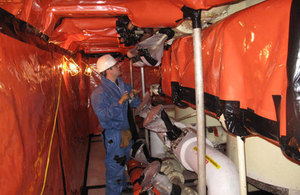Chapelcross completes largest asbestos removal project
Magnox Ltd has completed an 8-year project at Chapelcross site one year ahead of schedule and £5 million under budget.

Chapelcross asbestos project
The Chapelcross asbestos removal project is thought to be the largest known asbestos strip in Europe. Since the project began eight years ago, 3,300 tonnes of asbestos have been removed from the turbine hall, four reactor buildings and 16 heat exchangers. More than one million bags of asbestos waste (equivalent to filling four Olympic-sized swimming pools) were despatched to licensed landfill sites.
The original estimate for the project, completed in March, was £43 million against an actual cost of £38 million. Completing this work achieves 2 decommissioning milestones for the Chapelcross site.
Site Director John Grierson said:
This is a tremendous achievement for Chapelcross and OCS Environmental Services; the safe, early and cost efficient delivery is testament to the quality of the personnel working on the project. It is a major milestone in moving the site towards a care and maintenance state and demonstrates our commitment to excellence in nuclear decommissioning.
Before the actual asbestos strip could commence in 2009, two years were taken to erect a containment structure around each of the 16 heat exchangers to aid the construction of asbestos enclosures and protect the asbestos from further damage by wind and rain.
To construct the containment 506,246 feet of steel scaffolding was used, along with 194,576 fittings, 276 ladders, 48.84 tonnes of steel strengthening and 24,000 square metres of Powerclad sheeting. The whole thing took 39,000 man-hours to erect. The scaffolding boards used for the containment, if placed end to end, would stretch from Manchester to Bristol.
Polythene enclosures ensured that staff were protected from any exposure during asbestos removal operations and ensured that asbestos fibres were safely contained.
Once the bulk asbestos was removed, the steelwork was fine-cleaned and taken back to bare metal before being washed down. The fibre levels inside and adjacent to the enclosure were monitored by a team of independent asbestos analysts from Environmental Evaluation.
Brian Burnett, Head of Programmes at the NDA, said:
The safe removal of 3,300 tonnes of asbestos at Chapelcross completes an important hazard reduction activity for the site and a key step on the path to care and maintenance. I commend Chapelcross and Magnox on completing this project.
Project challenges
-
Largest-known asbestos removal project in Europe, second largest in the world
-
Safe removal of 3300 tonnes of asbestos and Man Made Mineral Fibre (MMMF) from four reactor buildings, 16 heat exchangers, turbine hall and ancillary pipework (2,400 tonnes on reactors / heat exchangers and 900 tonnes in turbine hall)
-
Ensuring a safe working environment for the workforce
-
Protecting the surrounding environment by ensuring all the asbestos was contained
-
Physically demanding work for long periods of time where radiation dose rates were present
-
Working in temperatures varying from minus 13 degrees centigrade to 28 degrees centigrade
-
Characterisation of bulk asbestos waste carried out for the first time, resulting in no waste sent to Low Level Waste Repository (LLWR) at Drigg – licensed landfill sites used instead
Contractor: OCS Environmental Services